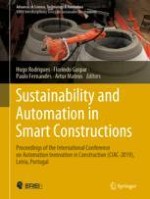2021 | OriginalPaper | Chapter
3D Printing for Construction Using Stone Sludge
Authors : Vani Annappa, Florindo Gaspar, Artur Mateus, João Vitorino
Published in: Sustainability and Automation in Smart Constructions
Publisher: Springer International Publishing
Activate our intelligent search to find suitable subject content or patents.
Select sections of text to find matching patents with Artificial Intelligence. powered by
Select sections of text to find additional relevant content using AI-assisted search. powered by
